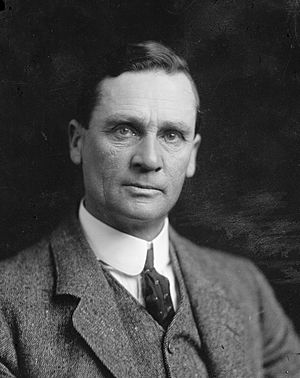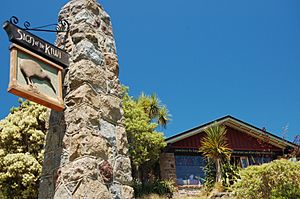Sign of the Kiwi facts for kids
The Sign of the Kiwi is a cool café and shop located at Dyers Pass. It sits on a road that connects Christchurch and Governors Bay. It was built by Harry Ell between 1916 and 1917. Harry Ell wanted it to be a place where travelers could stop and rest. It first opened as a tearoom, serving drinks and snacks.
This building is very important historically. Heritage New Zealand has given it a special 'Category I' heritage status. It's a popular spot for both visitors and people who live nearby. The Sign of the Kiwi closed after the big 2011 Christchurch earthquake on February 22. It took six years, but it finally reopened on January 23, 2017. Even though it was in the area affected by the 2017 Port Hills fires a month later, the building itself was not damaged.
Contents
Harry Ell's Big Idea: The Summit Road
Harry Ell was a very dedicated person. He was a Member of Parliament (from 1899 to 1919) and also served on the Christchurch City Council. Harry spent much of his life working to protect the natural bush areas. These areas were on the Port Hills of Banks Peninsula.
A big part of his plan was to make these beautiful places easy for everyone to visit. He suggested building a special road called the Summit Road. This road would go along the tops of the hills. It would connect Godley Head all the way to the hills above Akaroa.
Many people thought the areas Harry wanted to protect were too far away. But Harry was good at working with landowners. He also managed to get some money from the government. He often paid a small deposit for land first. Then he would raise the rest of the money later.
In 1909, Harry decided to create the Summit Road Scenic Reserve Board. This group was meant to help him make his dream come true. However, there were some disagreements. The board wanted to have a say in how things were done. But Harry saw them mostly as a group to help raise money. By 1915, Harry had bought 23 reserves in the Port Hills. He did this by buying private land. The board didn't always approve these projects beforehand.
By the 1930s, the road had been planned out. It reached as far south as the saddle above Pigeon Bay.
Rest Stops Along the Way
Harry Ell imagined building rest houses along the Summit Road. These would be places for people to stop and relax. The first rest house he built was the Sign of the Bellbird. It was built in 1914 at Kennedy's Bush. This was also where Harry set up his very first scenic reserve in 1906.
The second rest house was the Sign of the Packhorse. This was a smaller building. It was built in 1916 on top of the Kaituna Saddle. The Sign of the Kiwi was the third rest house Harry built. The Sign of the Takahe was the last one he planned to build.
Building the Kiwi and the Toll Gate
In 1915, the Summit Road Scenic Reserve Board found out about Harry's plan. He wanted to build a toll house in Coronation Hill Reserve. This reserve was created in 1912. It celebrated the crowning of King George V the year before.
The board didn't like Harry's idea for a toll house. But Harry went ahead anyway. Construction of the Toll House, as it was first called, began in 1916. Harry borrowed money from friends to build it. The Sign of the Kiwi officially opened on June 9, 1917.
Harry's plan was to collect money from a toll gate. This money would help pay for the rest of the Summit Road. The toll gate was set up in 1922. This happened after the Heathcote County Council agreed to it.
The toll gate caused a lot of arguments. People disagreed about whether paying the toll should be required. When the Main Highways Board took over the road, drivers started to complain. They were already paying taxes for road maintenance. They felt it wasn't fair to pay another toll to use the road.
The Canterbury Automobile Association spoke up for the drivers. They wanted the toll gate removed completely. The Heathcote County Council suggested that the toll should be optional. But Harry Ell strongly believed the toll had to be required. He even used the newspapers to make his point. He famously said:
I am making my will tomorrow, and am going to live in the toll house myself – and I am not coming out alive! ... I am going to move up there and take the tolls myself, until they kill me.
In October 1932, the Heathcote County Council told Harry to stop collecting tolls. But the nearby Halswell County Council helped out. They saw the benefit of Harry collecting money for the Summit Road. They suggested moving the toll gate. Harry then put up a new toll gate about half a mile south. It was in the Halswell County Council area, near Marley Hill. He even said a new toll lodge would be built there in the Tudor style. However, this never happened. Harry Ell passed away in June 1934. After he died, the new toll gate was also removed.
In 1920, Harry Ell's wife, Ada, started running the tea rooms at the Sign of the Kiwi. This happened after a disagreement with the Summit Road Scenic Reserve Board. A new chairman, William Machin, took over the board. He put ads in all four Christchurch newspapers. The ads said the board would not pay for any debts Harry Ell made.
Harry was very angry about this. He wrote to the Prime Minister, William Massey. He also got the new Commissioner of Crown Lands in Christchurch to make him the caretaker of the Sign of the Kiwi. The board didn't like this, but Harry just moved in. His wife taking over the tea rooms helped solve the problem. Unlike the person who ran it before, Ada managed to make a profit every year. But she became very stressed in 1926 and had to move out.
During World War II, the Sign of the Kiwi was left empty. The Department of Lands and Survey closed the building in the 1940s. In 1948, the building was given to the Christchurch City Council. They used it as a home for a caretaker. People could only go onto the porch.
In 1989, work began to fix up the building to be a refreshment place again. It reopened and also became an information center. There are many fun outdoor activities nearby. The Sign of the Kiwi is still a favorite spot for both locals and visitors.
The big 2011 Christchurch earthquake on February 22 damaged the shop. It took some time to realize how serious the damage was. The building stayed open for a while. It was made stable to prevent more damage. A detailed check found that it was only 9.5% as strong as building rules required. The legal minimum is 33%.
The repairs and structural upgrades started in October 2015. They cost NZ$760,000. The Sign of the Kiwi reopened on January 23, 2017. Even though it was in the area that burned during the 2017 Port Hills fires, the building was not harmed by the fire.
How the Kiwi Was Built
The Sign of the Kiwi was designed by a local architect named Samuel Hurst Seager. He was known for his knowledge about lighting art galleries. Seager also designed the two earlier rest houses on the Summit Road.
He was very interested in vernacular architecture. This is a way of building that uses local materials and traditions. It helps meet the needs of the area. The building is in the bungalow style. The inside walls are not covered, which gives the building a unique look. It uses local stone and is built low to the ground. This helps the building blend in well with the beautiful nature around it.







